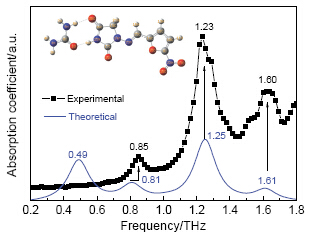| [1] Tous, S. S.; Mohammed, F. A.; Sayed, M. A. J. Drug Delivery Sci. Technol. 2008, 18, 367.
[2] Li, W.; Chen, J.; Xiang, B. R.; An, D. K. Acta Chim. Sinica 2001, 59, 109. (李伟, 陈坚, 相秉仁, 安登魁, 化学学报, 2001, 59, 109.)
[3] Eyjolfsson, R. Drug Dev. Ind. Pharm. 1999, 25, 105.
[4] Otsuka, M.; Matsuda, Y. J. Pharm. Pharmacol. 1993, 45, 406.
[5] Schultheiss, N.; Newman, A. Cryst. Growth Des. 2009, 9, 2950.
[6] Desiraju, G. R. J. Am. Chem. Soc. 2013, 135, 9952.
[7] Vishweshwar, P.; McMahon, J. A.; Bis, J. A.; Zaworotko, M. J. J. Pharm. Sci. 2006, 95, 499.
[8] Du, Y.; Xia, Y.; Zhang, H.; Hong, Z. Spectrochim. Acta, Part A 2013, 111, 192.
[9] Agbolaghi, S.; Abbasi, F.; Abbaspoor, S.; Alizadeh-Osgouei, M. Eur. Polym. J. 2015, 66, 108.
[10] Alhalaweh, A.; Roy, L.; Rodriguez-Hornedo, N.; Velaga, S. P. Mol. Pharm. 2012, 9, 2605.
[11] Vangala, V. R.; Chow, P. S.; Tan, R. B. H. Cryst. Growth Des. 2012, 12, 5925.
[12] Alhalaweh, A.; George, S.; Basavoju, S.; Childs, S. L.; Rizvi, S. A. A.; Velaga, S. P. Cryst. Eng. Commun. 2012, 14, 5078.
[13] Tutughamiarso, M.; Bolte, M.; Wagner, G.; Egert, E. Acta Crystallogr. Sect. C: Cryst. Struct. Commun. 2011, 67, O18.
[14] Vangala, V. R.; Chow, P. S.; Tan, R. B. H. Cryst. Eng. Commun. 2011, 13, 759.
[15] Cherukuvada, S.; Babu, N. J.; Nangia, A. J. Pharm. Sci. 2011, 100, 3233.
[16] Aaltonen, J.; Strachan, C. J.; Pollanen, K.; Yliruusi, J.; Rantanen, J. J. Pharm. Biomed. Anal. 2007, 44, 477.
[17] Li, X. R.; Guo, W.; Lu, Y.; Acta Chim. Sinica 2008, 66, 515. (李向荣, 郭伟, 卢雁, 化学学报, 2008, 66, 515.)
[18] Jin, T. S.; Zhao, Y.; Liu, L. B.; Li, T. S. Chin. J. Org. Chem. 2006, 26, 975. (靳通收, 赵莹, 刘利宾, 李同双, 有机化学, 2006, 26, 975.)
[19] Yang, J.; Li, S.; Zhao, H.; Song, B.; Zhang, G.; Zhang, J.; Zhu, Y.; Han, J. J. Phys. Chem. A 2014, 118, 10927.
[20] Xu, J. Z.; Zhang, X. C. Technology and Applications of Terahertz Wave, Peking University Press, Beijing, 2007, pp. 1~5. (许景周, 张希成, 太赫兹波科学技术与应用, 北京大学出版社, 北京, 2007, pp. 1~5.)
[21] Delaney, S. P.; Korter, T. M. J. Phys. Chem. A 2015, 119, 3269.
[22] King, M. D.; Korter, T. M. Cryst. Growth Des. 2011, 11, 2006.
[23] Du, Y.; Zhang, H.; Xue, J.; Fang, H.; Zhang, Q.; Xia, Y.; Li, Y.; Hong, Z. Spectrochim. Acta, Part A 2015, 139, 488.
[24] Kang, X. S.; Hou, D. B.; Zhang, G. X.; Chen, X. A.; Yue, F. H.; Huang, P. J.; Zhou, Z. K. Spectrosc. Spec. Anal. 2012, 32, 1744. (康旭升, 侯迪波, 张光新, 陈锡爱, 岳飞亨, 黄平捷, 周泽魁, 光谱学与光谱分析, 2012, 32, 1744.)
[25] King, M. D.; Davis, E. A.; Smith, T. M.; Korter, T. M. J. Phys. Chem. A. 2011, 115, 11039.
[26] Bertolasi, V.; Gilli, P.; Ferretti, V.; Gilli, G. Acta Crystallogr. Sect. C: Cryst. Struct. Commun. 1993, 49, 741.
[27] Fang, H. X.; Zhang, Q.; Zhang, H. L.; Du, Y.; Hong, Z. Acta Phys.-Chim. Sin. 2015, 31, 22. (方虹霞, 张琪, 张慧丽, 杜勇, 洪治, 物理化学学报, 2015, 31, 22.)
[28] Wang, X. M.; Wang, W. N. Acta Chim. Sinica 2008, 66, 2248. (王雪美, 王卫宁, 化学学报, 2008, 66, 2248.)
[29] Frisch, M. J.; Trucks, G. W.; Schlegel, H. B.; Scuseria, G. E.; Robb, M. A.; Cheeseman, J. R.; Montgomery, Jr. J. A.; Vreven, T.; Kudin, K. N.; Burant, J. C.; Millam, J. M.; Iyengar, S. S.; Tomasi, J.; Barone, V.; Mennucci, B.; Cossi, M.; Scalmani, G.; Rega, N.; Petersson, G. A.; Nakatsuji, H.; Hada, M.; Ehara, M.; Toyota, K.; Fukuda, R.; Hasegawa, J.; Ishida, M.; Nakajima, T.; Honda, Y.; Kitao, O.; Nakai, H.; Klene, M.; Li X.; Knox, J. E.; Hratchian, H. P.; Cross, J. B.; Bakken, V.; Damo, C.; Jaramillo, J.; Gomperts, R.; Tratmann, R. E.; Yazyev, O.; Austin, A. J.; Cammi, R.; Pomelli, C.; Ochterski, J. W.; Ayala, P. Y.; Morokuma, K.; Voth, G. A.; Salvador, P.; Dannenberg, J. J.; Zakrzewski, V. G.; Dapprich, S.; Daniels, A. D.; Strain, M. C.; Farkas, O.; Malick, D. K.; Rabuck, A. D.; Raghavachari, K.; Foresman, J. B.; Ortiz, J. V.; Cui, Q.; Baboul, A. G.; Clifford, S.; Cioslowski, J.; Stefanov, B. B.; Liu, G.; Liashenko, A.; Piskorz, P.; Komaromi, I.; Martin, R. L.; Fox, D. J.; Keith, T.; Al-Laham, M. A.; Peng, C. Y.; Nanayakkara, A.; Challacombe, M.; Gill, P. M. W.; Johnson, B.; Chen, W.; Wong, M. W.; Gonzalez, C.; Pople, J. A. Gaussian 03, Revision E. 01; Gaussian, Inc., Wallingford, CT, 2004.
[30] Islam, S. M.; Huelin, S. D.; Dawe, M.; Poirier, R. A. J. Chem. Theory Comput. 2008, 4, 86. |
